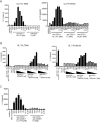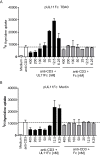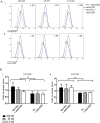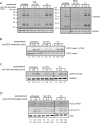The human cytomegalovirus glycoprotein pUL11 acts via CD45 to induce T cell IL-10 secretion
- PMID: 28628650
- PMCID: PMC5491327
- DOI: 10.1371/journal.ppat.1006454
The human cytomegalovirus glycoprotein pUL11 acts via CD45 to induce T cell IL-10 secretion
Abstract
Human Cytomegalovirus (HCMV) is a widespread pathogen, infection with which can cause severe disease for immunocompromised individuals. The complex changes wrought on the host's immune system during both productive and latent HCMV infection are well known. Infected cells are masked and manipulated and uninfected immune cells are also affected; peripheral blood mononuclear cell (PBMC) proliferation is reduced and cytokine profiles altered. Levels increase of the anti-inflammatory cytokine IL-10, which may be important for the establishment of HCMV infections and is required for the development of high viral titres by murine cytomegalovirus. The mechanisms by which HCMV affects T cell IL-10 secretion are not understood. We show here that treatment of PBMC with purified pUL11 induces IL-10 producing T cells as a result of pUL11 binding to the CD45 phosphatase on T cells. IL-10 production induced by HCMV infection is also in part mediated by pUL11. Supernatants from pUL11 treated cells have anti-inflammatory effects on untreated PBMC. Considering the mechanism, CD45 can be a positive or negative regulator of TCR signalling, depending on its expression level, and we show that pUL11 also has concentration dependent activating or inhibitory effects on T cell proliferation and on the kinase function of the CD45 substrate Lck. pUL11 is therefore the first example of a viral protein that can target CD45 to induce T cells with anti-inflammatory properties. It is also the first HCMV protein shown to induce T cell IL-10 secretion. Understanding the mechanisms by which pUL11-induced changes in signal strength influence T cell development and function may provide the basis for the development of novel antiviral treatments and therapies against immune pathologies.
Conflict of interest statement
The authors have declared that no competing interests exist.
Figures








Similar articles
-
Human Cytomegalovirus pUL11, a CD45 Ligand, Disrupts CD4 T Cell Control of Viral Spread in Epithelial Cells.mBio. 2022 Dec 20;13(6):e0294622. doi: 10.1128/mbio.02946-22. Epub 2022 Nov 29. mBio. 2022. PMID: 36445084 Free PMC article.
-
The human cytomegalovirus UL11 protein interacts with the receptor tyrosine phosphatase CD45, resulting in functional paralysis of T cells.PLoS Pathog. 2011 Dec;7(12):e1002432. doi: 10.1371/journal.ppat.1002432. Epub 2011 Dec 8. PLoS Pathog. 2011. PMID: 22174689 Free PMC article.
-
Exploitation of Interleukin-10 (IL-10) Signaling Pathways: Alternate Roles of Viral and Cellular IL-10 in Rhesus Cytomegalovirus Infection.J Virol. 2016 Oct 14;90(21):9920-9930. doi: 10.1128/JVI.00635-16. Print 2016 Nov 1. J Virol. 2016. PMID: 27558431 Free PMC article.
-
[Interrelationship between human cytomegalovirus infection and chemokine].Nihon Rinsho. 1998 Jan;56(1):69-74. Nihon Rinsho. 1998. PMID: 9465667 Review. Japanese.
-
Human leukocyte antigen E in human cytomegalovirus infection: friend or foe?Acta Biochim Biophys Sin (Shanghai). 2012 Jul;44(7):551-4. doi: 10.1093/abbs/gms032. Epub 2012 May 9. Acta Biochim Biophys Sin (Shanghai). 2012. PMID: 22576308 Review.
Cited by
-
Human Cytomegalovirus Interleukin 10 Homologs: Facing the Immune System.Front Cell Infect Microbiol. 2020 Jun 9;10:245. doi: 10.3389/fcimb.2020.00245. eCollection 2020. Front Cell Infect Microbiol. 2020. PMID: 32582563 Free PMC article. Review.
-
The Roseoloviruses Downregulate the Protein Tyrosine Phosphatase PTPRC (CD45).J Virol. 2021 Jun 24;95(14):e0162820. doi: 10.1128/JVI.01628-20. Epub 2021 Jun 24. J Virol. 2021. PMID: 33952641 Free PMC article.
-
Human Cytomegalovirus pUL11, a CD45 Ligand, Disrupts CD4 T Cell Control of Viral Spread in Epithelial Cells.mBio. 2022 Dec 20;13(6):e0294622. doi: 10.1128/mbio.02946-22. Epub 2022 Nov 29. mBio. 2022. PMID: 36445084 Free PMC article.
-
Protein tyrosine phosphatase receptor type C (PTPRC or CD45).J Clin Pathol. 2021 Sep;74(9):548-552. doi: 10.1136/jclinpath-2020-206927. Epub 2021 May 26. J Clin Pathol. 2021. PMID: 34039664 Free PMC article. Review.
-
Deciphering the Potential Coding of Human Cytomegalovirus: New Predicted Transmembrane Proteome.Int J Mol Sci. 2022 Mar 2;23(5):2768. doi: 10.3390/ijms23052768. Int J Mol Sci. 2022. PMID: 35269907 Free PMC article.
References
-
- Cannon MJ, Schmid DS, Hyde TB. Review of cytomegalovirus seroprevalence and demographic characteristics associated with infection. Reviews in Medical Virology. 2010. pp. 202–213. doi: 10.1002/rmv.655 - DOI - PubMed
-
- Ludwig A, Hengel H. Epidemiological impact and disease burden of congenital cytomegalovirus infection in Europe. Euro Surveill. 2009;14: 26–32. - PubMed
-
- Ramanan P, Razonable RR. Cytomegalovirus infections in solid organ transplantation: a review. Infect Chemother. 2013;45: 260–71. doi: 10.3947/ic.2013.45.3.260 - DOI - PMC - PubMed
-
- Hebart H, Einsele H. Clinical aspects of CMV infection after stem cell transplantation. Human Immunology. 2004. pp. 432–436. doi: 10.1016/j.humimm.2004.02.022 - DOI - PubMed
-
- Randolph-Habecker J, Iwata M, Torok-Storb B. Cytomegalovirus mediated myelosuppression. J Clin Virol. 2002;25 Suppl 2: S51–6. - PubMed
MeSH terms
Substances
LinkOut - more resources
Full Text Sources
Other Literature Sources
Medical
Molecular Biology Databases
Research Materials
Miscellaneous

